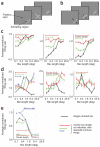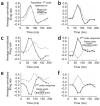End stopping in V1 is sensitive to contrast
- PMID: 16633342
- PMCID: PMC2645271
- DOI: 10.1038/nn1693
End stopping in V1 is sensitive to contrast
Abstract
Common situations that result in different perceptions of grouping and border ownership, such as shadows and occlusion, have distinct sign-of-contrast relationships at their edge-crossing junctions. Here we report a property of end stopping in V1 that distinguishes among different sign-of-contrast situations, thereby obviating the need for explicit junction detectors. We show that the inhibitory effect of the end zones in end-stopped cells is highly selective for the relative sign of contrast between the central activating stimulus and stimuli presented at the end zones. Conversely, the facilitatory effect of end zones in length-summing cells is not selective for the relative sign of contrast between the central activating stimulus and stimuli presented at the end zones. This finding indicates that end stopping belongs in the category of cortical computations that are selective for sign of contrast, such as direction selectivity and disparity selectivity, but length summation does not.
Figures







Similar articles
-
The role of V1 surround suppression in MT motion integration.J Neurophysiol. 2010 Jun;103(6):3123-38. doi: 10.1152/jn.00654.2009. Epub 2010 Mar 24. J Neurophysiol. 2010. PMID: 20457860 Free PMC article.
-
Attentional modulation strength in cortical area MT depends on stimulus contrast.Neuron. 2002 Jul 18;35(2):365-70. doi: 10.1016/s0896-6273(02)00778-x. Neuron. 2002. PMID: 12160753
-
Direction selectivity of neurons in the striate cortex increases as stimulus contrast is decreased.J Neurophysiol. 2006 Apr;95(4):2705-12. doi: 10.1152/jn.00885.2005. Epub 2005 Nov 23. J Neurophysiol. 2006. PMID: 16306177
-
Central neural mechanisms for detecting second-order motion.Curr Opin Neurobiol. 1999 Aug;9(4):461-6. doi: 10.1016/S0959-4388(99)80069-5. Curr Opin Neurobiol. 1999. PMID: 10448168 Review.
-
Phenomenology and neurophysiological correlations: two approaches to perception research.Vision Res. 2009 Jun;49(12):1507-21. doi: 10.1016/j.visres.2009.02.022. Epub 2009 Mar 20. Vision Res. 2009. PMID: 19303897 Review.
Cited by
-
Terminator disparity contributes to stereo matching for eye movements and perception.J Neurosci. 2013 Nov 27;33(48):18867-79. doi: 10.1523/JNEUROSCI.3332-13.2013. J Neurosci. 2013. PMID: 24285893 Free PMC article.
-
Columnar processing of border ownership in primate visual cortex.Elife. 2021 Nov 30;10:e72573. doi: 10.7554/eLife.72573. Elife. 2021. PMID: 34845986 Free PMC article.
-
The neural basis of tactile motion perception.J Neurophysiol. 2014 Dec 15;112(12):3023-32. doi: 10.1152/jn.00391.2014. Epub 2014 Sep 24. J Neurophysiol. 2014. PMID: 25253479 Free PMC article. Review.
-
Perspectives on science and art.Curr Opin Neurobiol. 2007 Aug;17(4):476-82. doi: 10.1016/j.conb.2007.07.010. Epub 2007 Sep 11. Curr Opin Neurobiol. 2007. PMID: 17851068 Free PMC article. Review.
-
The responses of V1 cortical neurons to flashed presentations of orthogonal single lines and edges.J Neurophysiol. 2015 Apr 1;113(7):2676-81. doi: 10.1152/jn.00940.2014. Epub 2015 Feb 11. J Neurophysiol. 2015. PMID: 25673741 Free PMC article.
References
-
- Adelson EH. Lightness perception and lightness illusions. In: Gazzaniga M, editor. The New Cognitive Neurosciences. MIT Press; Cambridge, MA: 2000. pp. 339–351.
-
- Attneave F. Some informational aspects of visual perception. Psychol. Rev. 1954;61:183–193. - PubMed
-
- Beck J, Prazdny K, Ivry R. The perception of transparency with achromatic colors. Percept. Psychophys. 1984;35:407–422. - PubMed
-
- Watanabe T, Cavanagh P. The role of transparency in perceptual grouping and pattern recognition. Perception. 1992;21:133–139. - PubMed
-
- Watanabe T, Cavanagh P. Transparent surfaces defined by implicit X junctions. Vision Res. 1993;33:2339–2346. - PubMed
Publication types
MeSH terms
Grants and funding
LinkOut - more resources
Full Text Sources

